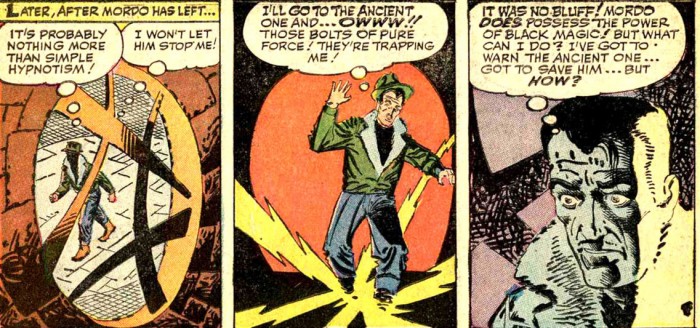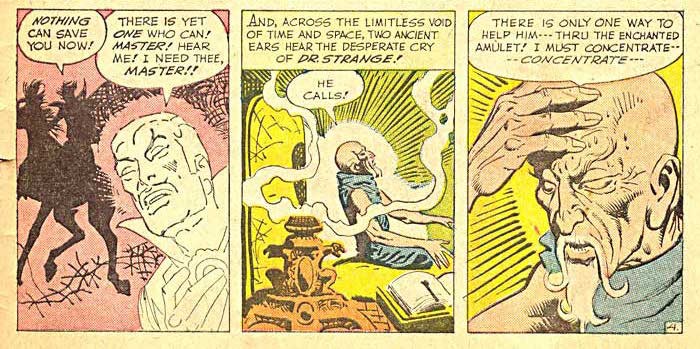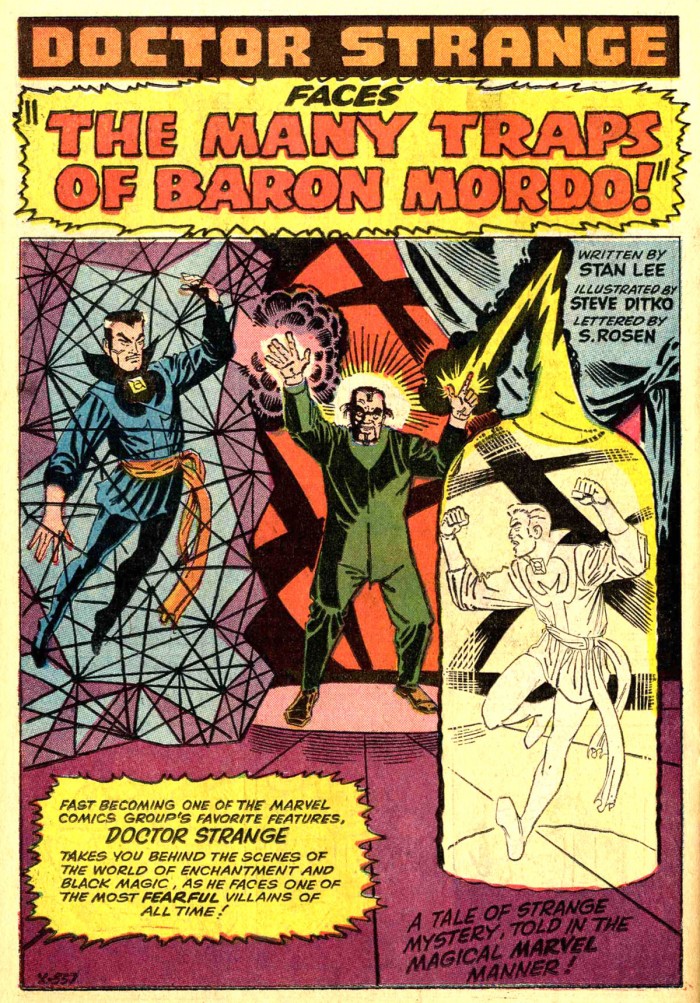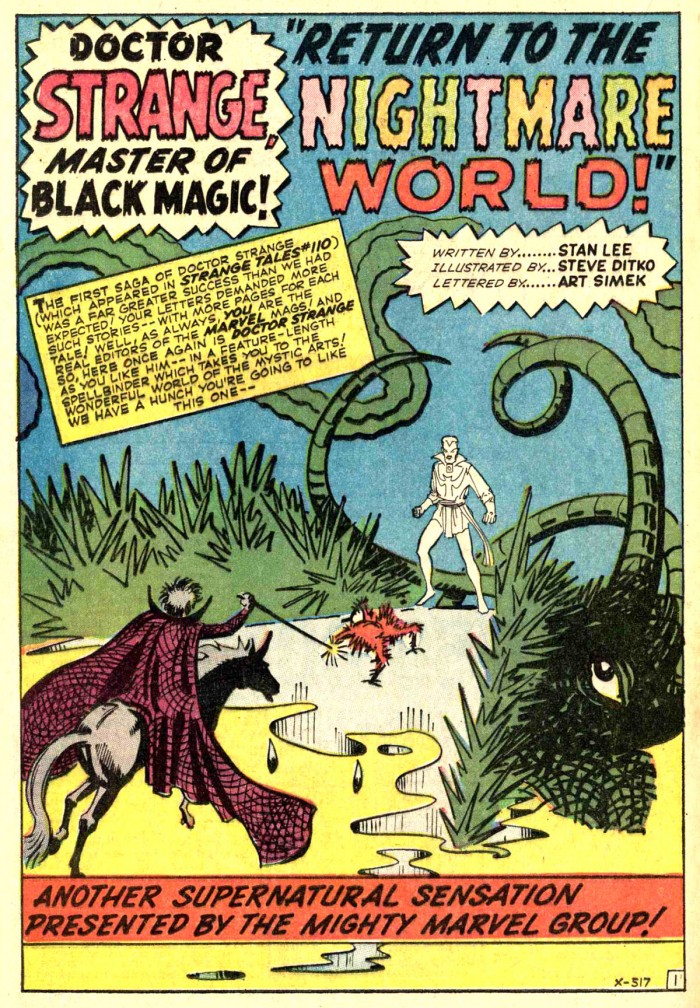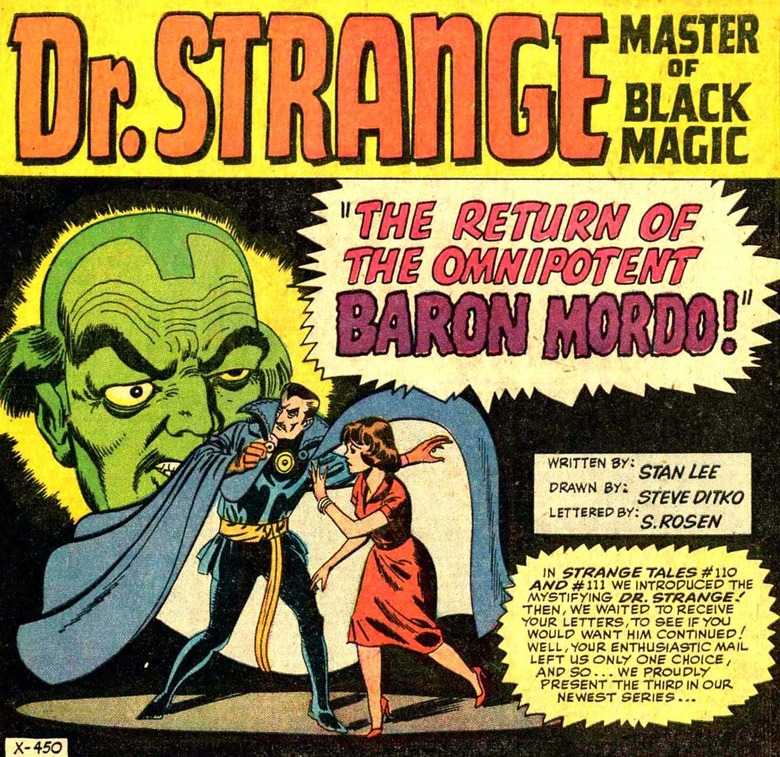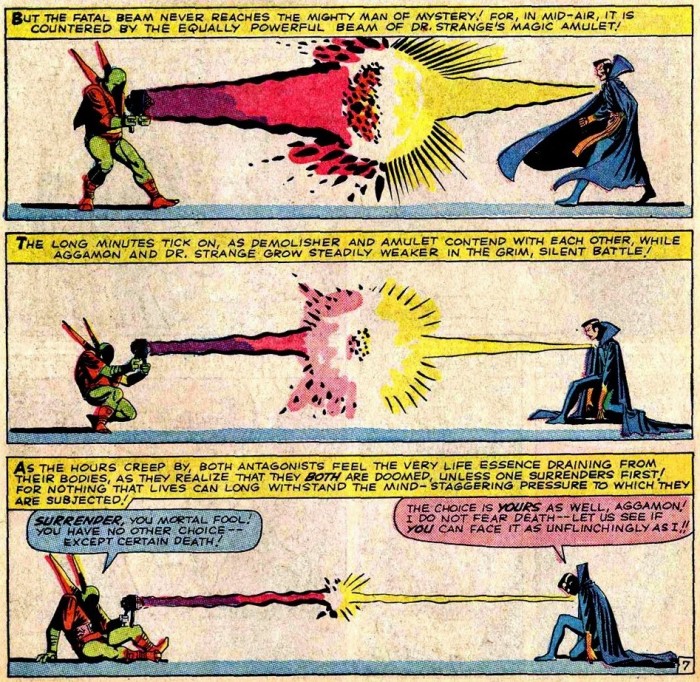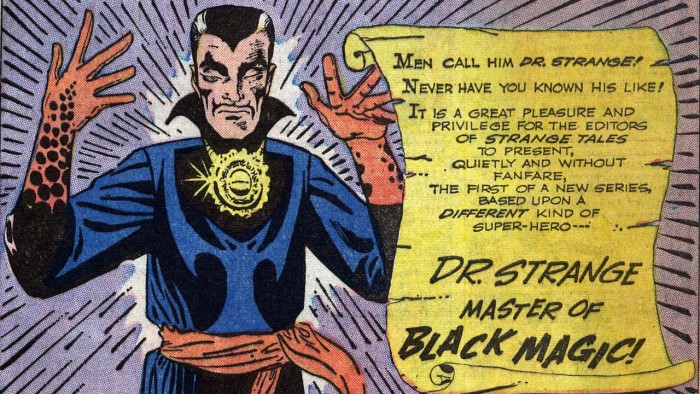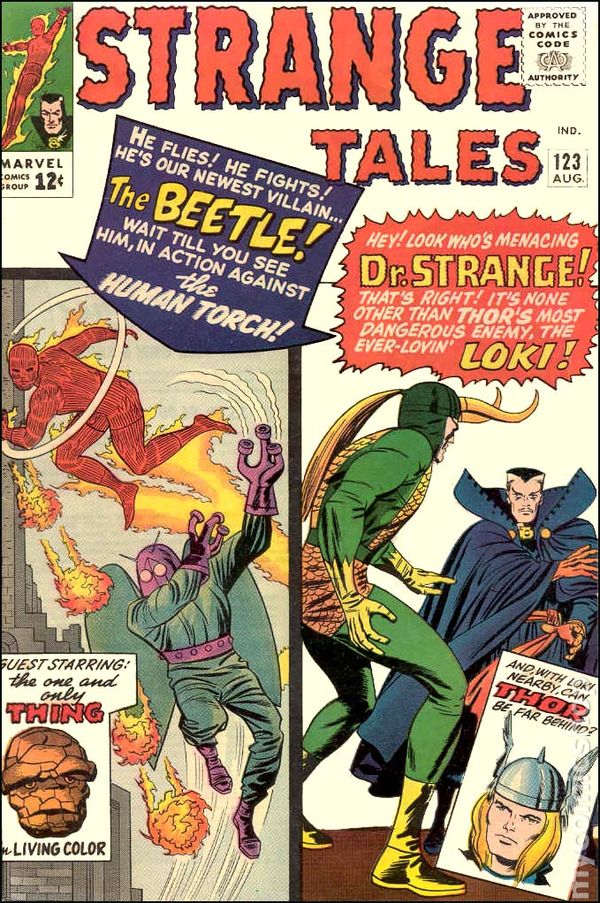Stephen Strange Vs. Steve Ditko: How 'Doctor Strange' Compares To The Original Marvel Comics
The new Doctor Strange movie has done what 50 years of comic book lore could not – it has made the the Marvel Universe's master of the mystical arts into a household name. Like Iron Man before him, Stephen Strange is no longer a B-tier superhero, beloved only by dedicated comic book readers. He now belongs to movie fans around the world.
Any character who has existed for half a century undergoes significant changes. But at the same time, any character who can exist for half a century has something at his core that allows him to endure for so long. So I decided to revisit the earliest Doctor Strange comics, written by Stan Lee and drawn by Steve Ditko, to see just how much the Sorcerer Supreme has evolved... and how much he's stayed the same. (Spoilers ahead for the Doctor Strange movie, if you haven't seen it yet.)
In the Beginning...
Dr. Stephen Strange, the master of the mystic arts, the Sorcerer Supreme of the Marvel Universe, does not have the most auspicious start. His first appearance comes in the pages of Strange Tales #110 and he's not even the main attraction. He's a five-page filler story in a comic series dedicated to the solo adventures of the Fantastic Four's Human Torch. He doesn't even earn a mention of any kind on the cover, which is more interested in asking the readers if Johnny Storm has met his match in villains known as "the Wizard and Paste-Pot Pete."
And unlike Spider-Man and the Fantastic Four, both of whom arrive with a bang in their first story, Doctor Strange's first adventure is a whiff. He doesn't even get an origin story at first: he's already a working practitioner of the working arts when a man plagued by horrible dreams visits him to request aid. Naturally, the good doctor enters the dream dimension to see seek out the source of the man's troubles (the first appearance of Strange's astral form, referred to here as his "metaphysical spirit"), briefly tussles with the villainous Nightmare, and learns that his client's dreams are a manifestation of his guilt over cheating various business partners.
Even if you meet the first Doctor Strange adventure halfway and recognize that it is a product of its time and place (a necessity when enjoying the early Marvel comics), it's one of the company's weaker debuts. But there's something here. Steve Ditko's art, while crude compared to the stunning and hypnotic work he'd be turning in by the end of his run, is undeniably weird and unsettling, feeling more like a '60s horror comic than a superhero tale. It's enough to counterbalance Stan Lee's dialogue and narration, which transform almost every panel into a chore (this also improves with time).
Doctor Strange would return for another quick five-page story in Strange Tales #111 (which introduces his arch-nemesis Baron Mordo), but he'd sit things out until Strange Tales #114. But that brief vacation does wonders for just about everything. Upon returning, Doctor Strange finally begins to look like himself (more on that in a bit) and the storytelling from Ditko and Lee starts to find a rhythm. He still isn't getting mentioned on the covers yet, but it's a start.
The Origin Story
The humble beginnings of Doctor Strange are finally unveiled in Strange Tales #115, the first issue to grant the character eight pages (the Human Torch's battle with the Spider-Man villain Sandman dominates the cover). When stripped down to its core, Strange's origin story follows the same beats as the new movie: talented, arrogant surgeon has his hands destroyed in a car accident, ventures to the Far East in search of a miracle cure, and meets a wizened old wizard named the Ancient One. He dismisses the talk of magic until he witnesses it first hand, defends the Ancient One against a murderous apprentice, and takes his first step toward commanding the mystic arts.
Of course, everything else is completely different. In this case, the murderous apprentice isn't Kaecilius, but Baron Mordo, a husky, square-jawed weirdo with bad facial hair who poisons the Ancient One so he can be the one true master of Earth's mystical forces. And the Ancient One isn't running an entire school filled with followers and disciples, but living an isolated existence in the mountains. It's pretty low-key as far as superhero origin stories go, especially since the Ancient One reveals that he was never in any real danger, knew about Mordo's intentions all along, and was just acting the part so Strange could find the goodness within him to step up and become his apprentice.
In comparison, the film's trial by fire involves Stephen Strange literally stepping up to save the world with the help of Mordo, who is still an ally when the credits roll (but changes his allegiance once they've finished rolling). It's a smart update, adding cinematic bombast and stakes to a scenario that was already old-hat in the '60s. Sending a westerner to Asia to learn superpowers from a wise old mystic was tired 50 years ago. The reinvention of the Ancient One's compound as a full-fledged academy where any who wish to learn are welcome is a necessary update, allowing Strange's journey and his destination to feel like a reflection of a globalized scenario rather than a copy-and-paste from an old pulp.
The Ancient One
In the Doctor Strange movie, the Ancient One is an ageless Celtic woman with a shaved head played by the great Tilda Swinton. In the early Doctor Strange comics, the Ancient One is an elderly Asian man with a Fu Manchue-esque facial hair and eyes that are in a permanent squint. To Lee and Ditko's credit, the Ancient One is portrayed as more powerful than Strange himself, a necessary ally who often steps in to help him whenever he's cornered. In the earliest tales, he's something of a deus ex machina – if Doctor Strange is in trouble, his teacher always intervenes at the last second to save the day. It's almost funny just how many times Strange requires the Ancient One to save his bacon in his own comic book.
But Lee and Ditko have also created something of its time. Something cringeworthy. In the first twelve issues of Strange Tales to feature Doctor Strange, we rarely see the Ancient One's eyes because his face has been contorted into every possible Asian stereotype. And while he may be a powerful character, the Ancient One is barely a character, speaking in platitudes that fluctuate between fortune cookie nonsense and tired chatter about the importance of good battling evil. While Strange himself is allowed to be flawed, to be clever, to have an inner life, the Ancient One borrows a series of Asian tropes and builds them into a character who, while an improvement over the depiction of Asian characters in other forms of American entertainment at the time, makes the skin crawl just enough today.
Director Scott Derrickson has spoken at length about the decisions that led him to make the cinematic version of the Ancient One a white woman instead of an Asian man and it's easy to recognize the conundrum. By whitewashing the character, he's sidestepping the inherent cliches of the character, avoiding the "wise Asian mystic" stereotype altogether. But he's also removing an Asian character from the playing field entirely, turning one of the most powerful characters in the Marvel universe into another white character.
And yet, Derrickson and Swinton's take on the Ancient One is ultimately superior to the comic book counterpart. Unlike the comic version, who never seems to stand up from his golden throne in his mountain compound, the film version of the Ancient One is an active hero, a charismatic leader, a badass warrior, and a deeply flawed, troubled woman whose own fears have led her to make poor decisions at the expense of the universe. While the whitewashing is a subject that must be discussed (and Derrickson's willingness to talk openly about it feels like an important step), there's no denying that Swinton's take on the character is more interesting than the non-entity introduced in the pages of Strange Tales.
In other words, I really love this new take on the character and think the cinematic Ancient One is richer and more human than the comic book version is just about every way. I just hate that it came at the expense of the character's race, removing one of the precious few Asian characters from the Marvel Universe.
Baron Mordo
It's startling to compare the earliest version of Mordo to the one portrayed by Chiwetel Ejiofor in the film. In his first appearances, Mordo is straight-up evil for the sake of evil, a power-hungry, monologuing schemer whose attempt to murder the Ancient One fails when Stephen Strange intervenes. From that point on, he declares war on Doctor Strange, viewing his former teacher's new student as the only roadblock keeping him from executing the Ancient One and dominating the world. He may be one of the least complex early Marvel villains. It doesn't help that his receding hairline, pudgy build, and unflattering green jumpsuit make him look more like the world's most evil janitor than a powerful supernatural foe.
And yet, to Ditko and Lee's endless credit, Mordo is portrayed as a genuine threat whenever he rears his ugly head. Every time they clash, Doctor Strange is forced to out-think and outwit his archenemy, acknowledging in the narration that he's the more powerful of them. There are a few adventures in these early issues where Doctor Strange walks into a bad situation, immediately reads the room, and solves the problem without breaking a sweat. But when Mordo shows up, you're in for a story where the hero really finds himself on the ropes.
The film adaptation echoes what's effective about Mordo while deepening him. Like his comic book counterpart, he's ruthless and damn good at what he does, schooling Stephen Strange more than once in physical prowess and magical abilities. He even wears a green costume as a tribute to that janitor onesie, although the updated armor sells him as a proper warrior.
However, the most important change is motivation. While comic book Mordo pretends to be an ally for about two pages before attempting to kill the Ancient One to obtain power for the sake of power, the cinematic Mordo is a staunch ally and supporter of the Ancient One who finds himself disillusioned over the course of the film. His final post-credits decision to declare war on earth's sorcerers is the result of his own personal despair and a crisis of faith. Ejiofor brings real pathos to Mordo, selling him as a broken man who has remade himself to be cruel rather than just another cackling supervillain.
Dormammu and Nightmare
The demon Dormammu doesn't make an appearance in the first year of Doctor Strange stories, but he sure gets mentioned an awful lot. One of Strange's most notable nemeses in the comics (second only to Mordo), the Dread One is the surprise villain of the new movie, popping up in the third act after Mads Mikkelsen's Kaecilius reveals himself to be a henchman for the ruler of the Dark Dimension. Strange's confrontation with him is very possibly the strongest scene in the movie and one of Marvel Studio's least conventional climaxes.
And if you ever wanted proof that the early Marvel comics were made up as they went along by creative geniuses who were operating by the seat of their pants, you only need to look to these twelve issues of Strange Tales. While Baron Mordo frequently calls upon the power of Dormammu when working his magic, Doctor Strange does as well. In these early adventures, the name Dormammu is treated as an abstract, neutral force, something that any sorcerer, good or evil, can call upon. Like Strange summoning energy from the "hosts of Hogoth," it's clear in these early stories that Dormammu was just a wacky word Lee made up to make Strange's magic sound truly alien. There's even one issue where Strange calls upon the powers of "Mormammu" to help him out of a jam, which feels less like Lee was trying to create a second source of power and more like he forgot the actual name he had been using in the prior issues.
The most amusing part of this is that the film reveals that the Ancient One has been calling upon Dormammu to maintain her immortality and it's treated as the ultimate betrayal. But in these first comics, Doctor Strange is just name-dropping him in the middle of every other spell. No big deal.
While Dormammu hangs out off-panel in these stories, another major Doctor Strange villain rears his ugly head a few times: Nightmare, the lord of the dream dimension and an entity who has had a bone to pick with Stephen Strange for some time now. Seriously. He shows up in Strange Tales #110, the first Doctor Strange villain in the first Doctor Strange story, and they're already being referred to as "ancient foes."
Nightmare is a frequent villain, rearing his ugly head three times in the first year of Doctor Strange, and his Dream Dimension allows Ditko to truly cut loose, creating all kinds of bizarre imagery and creatures. It's in these tales that you can see the origins of the infinite weirdness that would define later Doctor Strange stories (and the film adaptation). In one story, Nightmare pursues Doctor Strange through a nightmarish landscape while astride a black unicorn, siccing his pet "Spinybeast" against our hero. It's wild stuff and it's the high-water mark of these early adventures.
So its not wonder that Derrickson originally wanted Nightmare to be the lead villain of his film – he's a great bad guy and, literally, the first Doctor Strange villain.
Costume and Powers
When he first appears, Doctor Strange doesn't look quite like the Doctor Strange we know today. While the blue robe and the grayed temples are present, he's wearing the leopard print gloves and not wearing his iconic cloak. His "magical amulet" (it won't be named the Eye of Agamotto for this first year) is more ornate and seemingly the source of most of his power. Too many of these early stories conclude with Strange's amulet releasing the right energy at the right time to take down the bad guy.
Eventually, other pieces do come into play. He gets his cloak in his third appearance, but it's blue instead of red and is seemingly only there because it looks nifty. His home is introduced as being located in "New York's colorful Greenwich Village," but it won't be called the Sanctum Sanctorum quite yet (although the window and the front door do bear the symbol of the Eye of Agamotto).
Perhaps the most interesting exclusion is that no one ever refers to the Sorcerer Supreme, a title that will eventually be passed down from the Ancient One to Doctor Strange. This name, which designates the monster powerful mystic in a given dimension and will come to define Strange's identity for decades to come, only comes to exist later.
Naturally, the film adaptation is able to pick and choose from 50 years of history to build its Doctor Strange. His costume, while slightly busier than the comic book version (so many belts!), is a collection of every instantly recognizable costume the character has worn over the years. And while the film doesn't grant him the title of Sorcerer Supreme quite yet, it plants those seeds early on.
A Man With a Plan
Eventually, the early Doctor Strange stories in the pages of Strange Tales break out of their repetitive rut, find a groove, and get good. Sure, the Human Torch is still the star of each cover, but Strange himself starts to appear in the bottom corner, promising readers a new tale of black magic and supernatural derring-do. And because there are literally no limits to what a Doctor Strange story can be, Ditko and Lee really start to go all-out, telling some truly wild little tales. The highlights include Doctor Strange saving a reporter from a "haunted house" that is actually a sentient being from another dimension, rescuing a group of people who are being held hostage in their sleep by Nightmare, and doing battle with Aggamon, a sci-fi barbarian warlord who enslaves the inhabitants of countless dimensions from his palace "beyond the purple veil."
Watching Ditko and Lee throw away the superhero rulebook is thrilling. But the lack of familiar rules goes beyond the unfamiliar settings and into how their hero actually combats his enemies. It's telling that the Doctor Strange movie concludes with our hero trapping Dormammu in a time loop and wearing him down over thousands of deaths, literally talking his adversary into defeat, because that's exactly how Stephen Strange deals with so many of his foes in these early adventures.
Much like how Spider-Man was always battling his teenage insecurities, Doctor Strange is always aware that he's only a mortal human – he's outmatched in every single battle and knows it. While he has magical spells and ancient artifacts of great power at his disposal, Doctor Strange often finds himself relying on quick wits and desperate, makeshift plans to escape from every jam. Sometimes it's simple, like convincing an exhausted villain that he has power to spare while knowing that the bad guy would kill him should the battle continue. Other times, it requires a dirty trick, like creating the illusion of another villain to convince Nightmare to temporarily team up... only to turn on Nightmare instead. Doctor Strange isn't a fun character because he's a powerful mystic – he's a fun character because he gets crafty when he's pushed into a corner.
One More Note on Race...
While the whitewashing of the Ancient One remains a chief component of a conversation we'll be having for some time, not enough credit can be given to Scott Derrickson and his collaborators for how they transformed Wong for the big screen. In the early comics, Wong appears sparingly and each appearance is a cringeworthy affair. He's Strange's live-in manservant, literally yellow-skinned, and whose eyes are drawn as diagonal dashes. His broken English ("Forgive master! Officer of the law wishes to see you!") makes the skin crawl. Eventually, comic book Wong will evolve into more of a companion than a servant, but he's still the guy who does the hero's laundry and cooks his meals.
The cinematic Wong, played with deadpan humor and intelligence by Benedict Wong, is a necessary recreation. He's no longer a manservant, but a fellow sorcerer and advisor, the grumpy Q to Strange's James Bond. While the comic version of Wong exists to be subservient to the arrogant Strange, the cinematic version pushes back, tells him when he's being a fool, and provides a gruff conscience in key moments. In a film filled with smart adaptation choices, this may be the smartest.
It should also be noted that Doctor Strange himself does not appear to be fully white in his first appearances. It's difficult to pin down the exact ethnicity Ditko was going for with these early drawings, but Stephen Strange appears vaguely Asian or Middle Eastern in his first few adventures, presumably because an ethnic character would add a little extra mystique to the proceedings. However, Strange's vaguely ethnic appearance slowly vanishes with each new issue, with the character appearing more Caucasian in each adventure. It makes you imagine an alternate dimension, an Earth much like our own, where Stephen Strange was Marvel's first non-white hero and stayed that way.
The Larger Marvel Universe
Although the Marvel comic book universe was interconnected from its earliest days, Doctor Strange spends much of his first year existing in his own little bubble, sharing a New York City with Spider-Man and the Fantastic Four without ever crossing their path. Although his first brush with the other denizens of this world came when he guest-starred in Fantastic Four #27, he didn't confront the larger Marvel Universe in his own series until Strange Tales #123, when he faces off against Loki and defuses his plot to steal Thor's hammer for himself. In true Loki fashion, the scheming trickster god convinces Doctor Strange to help him with his plot, wearing a series of lies about Thor being the real threat. In true Doctor Strange fashion, the master of the mystic plays along to get to the bottom of the situation before fighting back.
So it's only appropriate that the Marvel Cinematic Universe version of Doctor Strange meets Thor during the credits of the new movie. Whether by accident or design, it's a fitting tribute to his first real brush with his fellow superheroes.
Also noteworthy is how the regular citizens of the Marvel comic book universe react to Doctor Strange. He doesn't hide his identity and even walks out in public in full superhero regalia. Everyone knows who he is, everyone is a little creeped out by him, and everyone wonders if he's for real or just a big fraud. Naturally, more than few people come to him when they encounter something they cannot explain, hoping that he's no charlatan.
Like the Fantastic Four (and later, Tony Stark), Stephen Strange bucks the superhero trend by not hiding behind a secret identity. His friends, and his enemies, know exactly where to find him. Whether or not future MCU films will treat him like this remains to be seen.

